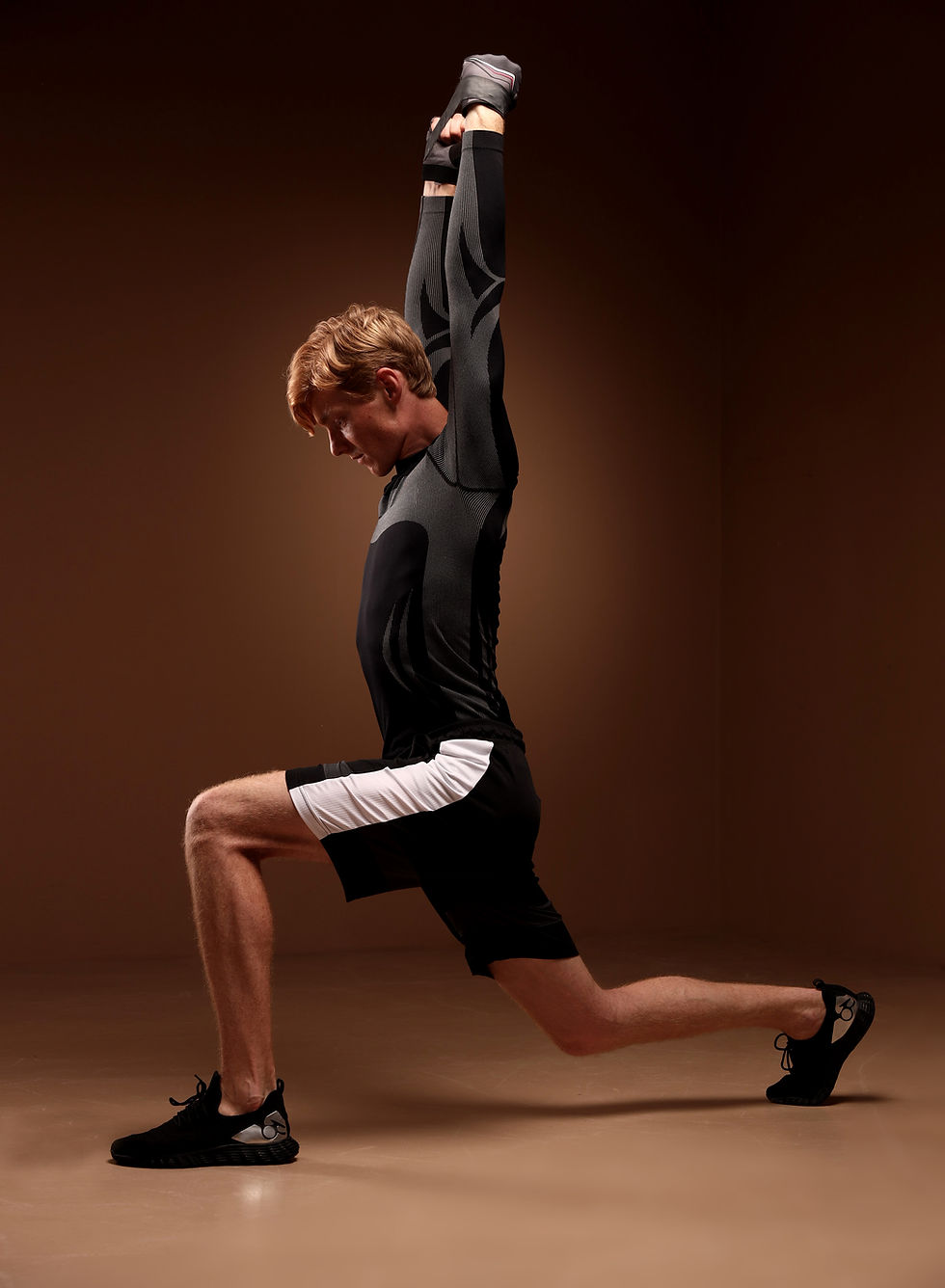A How To Guide on Increasing Muscle Mass
- krismarfit
- Jul 11, 2021
- 8 min read
Those in the weight training world or new to lifting weights will set goals for themselves. With each goal there’s a specific form of training that will work best to get you to your goals. The most common are weight loss, weight gain, increased tone of the body, and increasing muscle mass. You can reference my previous posts on more about weight loss, gain and toning. Today we will discuss increasing muscle mass or hypertrophy training.
Hypertrophy training is often a major goal for experienced lifters/bodybuilders. While you may be seeing steady increases in strength, you may not necessarily see an increase in the size of your actual muscles. The process of building muscle mass is complex, but an easy way to think about it, is to think about 2 major structures in the muscle: fibers and sarcomeres. When we train, tiny tears to the muscle fibers happen and when they “heal” the fibers fuse together and become bigger. The sarcomeres form alongside the fibers and increase size as well. It’s similar to braiding more strands into a rope. The tension in the muscle also sends signals to the brain to increase the production of muscle proteins that are used for muscle growth as well.

Building actual muscle mass vs. increasing strength are not the same. Most people link the 2 together and think that the stronger they are, the bigger their muscles and that’s actually not the case. There are a lot of other factors to consider. Below I’ve outlined some of the primary ways you can work toward building muscle and improving size. It’s important to keep in mind that everyone’s body responds differently and some take longer than others to show progress!
1) Adequate food
A lot of people who are trying to increase muscle size are eating in a calorie deficit, or less calories than their body needs to grow. Without enough calories, the body can not grow. You should make sure you know your body’s TDEE (more on that in one of my previous blogs), and eat the number of calories your body requires, or 100-300 calories more than that. Prioritize getting all your nutrients! You need fats, carbs and proteins. Also, make sure to get enough protein!
2) Rest
Get those 7-9 recommended hours of sleep! Sleep = muscle recovery. No muscle recovery means the muscles won’t be prepared for another training session. This will lead to faster muscular fatigue and increase risk of injury which can completely set back your progress.
3) Patience and Consistency
Don’t compare yourself to others on their hypertrophy journey. Some people are genetically predisposed to gaining more muscle than others, and some people gain muscle quickly and some slowly. You must practice patience as there will be minimal muscle gains in the first 1-2 months. The body needs time to adjust to the new process. Also, remember the act of gaining muscle is the tearing and repairing of a muscle. This takes time. Unfortunately, most people starting off only give themselves 1-2 months to “try out” weight training, and when they don’t see progress in that time, they quit.
Also be prepared, in the first year you'll gain the most muscle and then growth tapers off also known as the “genetic ceiling.” After the first year you’ll have to try out new strategies for gaining muscle. It’s also helpful to know that growth is not a linear process in weight training. You’ll go through periods of growth, plateaus, sometimes a decline (which will require a period of rest and recovery), and then growth again. Just continue practicing patience and consistency and you will start noticing the difference!

4) Mind-muscle Connection
If you’ve never heard of mind-muscle connection when training, it is truly key to muscular growth. When we do an exercise certain muscles are activated and are used to complete said exercise. Just because a certain muscle is engaged, though, doesn’t mean that’s the muscle that SHOULD be doing the work. If you have any muscular imbalances, the incorrect muscle may be engaged and throwing off your training. Many people who have been training for years still don’t practice this policy and wonder why growth in certain areas isn't happening.
If an exercise is meant to engage your glutes but when you do the exercise you feel it more in the quads, something isn’t right. When picking exercises for the day, make sure you know exactly which muscles they should engage. Then when doing that exercise, think about the muscle. Your brain is important in training! It tells your body what to do and can make sure the right muscle is working. Those who practice mind-muscle connection will often see better and faster engagement of muscles.
If you are training and notice that not even mind-muscle connection is helping, you may have some muscle imbalances. Try revising your stance and placement and see if that helps, otherwise a personal trainer may be essential for building a plan that can help your body function at 100%.

5) Muscle Symmetry to Reduce Imbalances
It’s very common that people set aesthetic goals with certain muscles as the primary focus for growth. The reality is that when we only focus on making some muscles stronger and larger, other muscles suffer. When exercising, you have muscles that are the primary mover and then supporting muscles. If your supporting muscles are weak, this will cause limitations and sometimes injury. To set yourself up for success and the greatest chance for hypertrophy, you must make sure you train all muscles including those small ones.
A good example is the rotator cuff, which is a smaller muscle and commonly injured. When we do exercises like overhead press or a chest press, if that rotator cuff isn’t strong enough, this can cause limitations and the rotator cuff could easily be injured. So make sure your workouts have a lot of variety and broad muscle engagement!

6) Hypertrophy is More Than Resistance Training and Weights
To give your body the best chance at maximal hypertrophy, you have to do more than just lift weights! You also need to focus on flexibility, cardio and core stabilization. Whether you are new to weight lifting or have been doing it for years, you may not realize the importance of flexibility for muscle growth. When you lack flexibility in a specific area, that means the muscles are shortened and overactive. When a muscle is shorten like this, it can't stretch fully to be able to have those microtears and the opportunity for repair and size increase. This also leaves other surrounding muscles not engaging when they need to, or over engaging that could lead to injury.
Cardio is often feared but is important for reducing body fat and done correctly is beneficial to adding muscle mass. Circuit training is a great way to combine both cardio and resistance training to build strength and burn calories. The key is to burn off fat and increase metabolic stress while limiting the chance of burning so many calories muscle growth can't happen.
Core stabilization is also one of the most valuable necessities to muscle hypertrophy. Your core is the trunk of the body and where all other muscles move from. Having a weak core can cause overall posture issues, and lessen engagement. This is why we hear “engage your core” so often in training. A strong core supports the body through any exercise you may do. Bodybuilders often have strong muscles in their legs and arms but lack core stability. These core stability exercises can improve the overall function and recruitment of other major muscles and improve strength and size.

7) Train in All Planes of Motion
To ensure growth of all muscles and all angels of muscles. We often forget that some muscles connect in multiple places and require multiple angles of training for full growth potential. When training there are actually 3 different planes of motion to think about. Frontal Plane is the movements from side to side like adduction and abduction. Then there’s the sagittal plane that refers to movements going forward and backwards like extension of the leg forward. Then there’s the transverse plane that deals with rotations of the body like swinging a golf club. We need to train in all 3 directions to maximize growth of the muscles!
8) Don’t use max weight!
When we train we are using up a lot of energy. With a good training session our body goes through what’s called metabolic stress. This stress signals the body to produce extra hormones that contribute to growth and repair. When we train with maximum weight we are doing very few reps and we are taking long breaks, this doesn’t lead to very much metabolic stress. We need to increase metabolic stress for muscle gains and doing max reps doesn’t do this, so it’s important to lower those weights to a more moderate level.
9) Don’t overtrain.
Remember that muscles need time to repair for hypertrophy to happen. If you train daily, your body won’t be able to fully repair and you’ll see more limited size change and you may end up overtraining and this could lead to exhaustion. Training 60 minute 3-4 times a week is all you need. A good exercise plan will also include 6-12 reps and 3-5 sets. This is why doing those 1 rep max exercises with the highest weight you can lift won't lead to as much progress.
Use a variety of exercises and between sets, take a 1-2 minute rest. This amount of rest will help to replenish energy levels while making sure the body stays in metabolic stress for the entire training session. Use a moderate (not fast) pace. Remember that the body needs to undergo tension to have those microtears. Most growth is also seen in the eccentric or lower phase of an exercise, because that is the part of the exercise when there’s the most strain to the body. So slow down those lowering phases. If you just quickly bang out those exercises you’ll reduce muscle engagement and lessen the chance of growth.

10) Practice Progressive Overload
Progressive overload is also great for strength and hypertrophy gains. This refers to the steady increase in weight over time. It allows the body to gradually get used to heavier weights so you can increase strength while avoiding just doing 1 rep of that heavy load and limiting engagement. Just know your limits and don’t be afraid to take a week here and there to greatly lighten the load and give the body a longer recovery time. Pay attention to how your body responds to not only the exercise but the weight you are doing.

Gaining muscle and increasing size can be a trying task, but once you can set a good routine for yourself and alter your training methods, you’ll actually find yourself getting a better workout that should not only lead to increased size, but better general health and energy levels. A lot of people who train for muscle size, tend to overdo their training and their body is in a constant state of exhaustion. I’d also like to mention for anyone that used to train and took a long period of time off, before starting again, do not fear starting over! Restarting after losing muscle mass can be rather defeating. You may feel bad for not keeping up momentum and losing progress, but that’s where the Principle of Reversibility comes into play. This refers to the ability of the body to remember how to perform an exercise and build muscle and you’ll notice faster results the second time around as your body wants to get back to a place it remembers. So don't fear starting over!
Until next time… and remember muscle growth is for all!




Comments